

Spaceship to clean up space unveiled. 1.
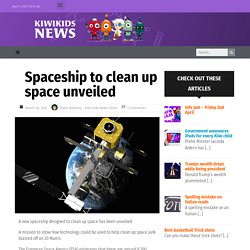
Who is the main person or group of people in this news article? 2. 4.6-Billion-Year-Old Meteorite Found In The Sahara Desert Is Older Than Earth Itself Kids News Article. An ancient volcanic space rock found in the Algerian Sahara, may provide scientists insights into the building blocks of planets.

Dubbed Erg Chech 002, or EC 002, the meteorite is believed to be a remnant of a protoplanet dating back 4.6 billion years — about the time when our solar system was being formed. The coarse-grained brown space rock, which is studded with green, yellow-green, and yellow-brown crystals, was found by meteor hunters in Adrar, Algeria, in May 2020. Unlike previously found meteorites, which comprise a kind of volcanic rock called basalt, Erg Chech 002 is composed of andesite. Though common in the Earth's subduction zones — the areas where tectonic plates have collided and one has been pushed beneath the other — andesite has rarely been seen in meteorites.
Since no known asteroid resembles EC 002, the researchers suspect that no other remnants are left from these early times. Resources: Newscientist.com, livescience.com, phys.com. A rare 'goldilocks' black hole has been discovered! - CBBC Newsround. PA Media The newly discovered black hole is approximately 55,000 times the mass of the sun and may have been created before the first stars and galaxies formed according to scientists Scientists in Australia have discovered a rare, medium-sized black hole that could help us estimate the total number of these objects in the universe.
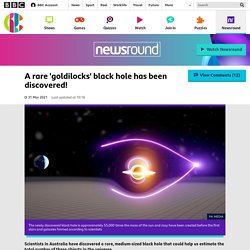
At the moment, there are two well-known types of black hole. Stellar black holes are usually between three and ten times the mass of our Sun and supermassive black holes, which exist at the centre of most galaxies, can reach masses that are millions, or even billions of times as heavy as the Sun. The newly discovered black hole, found by researchers at the University of Melbourne and Monash University, has been described as an 'intermediate-mass' or 'goldilocks' black hole as it weight sits between the stellar and supermassive black holes. Researchers estimate that there are around 46,000 intermediate-mass black holes in our galaxy alone. Meteor particles discovered in the Antarctic mountains thought to be 430,000 year old - CBBC Newsround.
Scott Peterson/PA Wire Meteor particles have been found in Antarctic ice dating from a collision with Earth 430,000 years ago.

It's a discovery that could help scientists learn more about asteroid landings and how often they may happen in the future. Researchers found these extra-terrestrial particles on the Sor Rondane mountains in east Antarctica. The discovery shows that there was a "low-altitude meteoric touchdown event", where melted asteroid material 100 meters in size splattered on the surface. The research was published in Science Advances journal and explains how it is "critical to understanding the impact history of Earth and estimating hazardous effects of asteroid impacts".
Treasures from Japanese Hayabusa 2 space capsule revealed after landing near Woomera in South Australia. When a space capsule landed in the South Australian outback in December, it was carrying precious items from deep space that had never been seen on Earth.
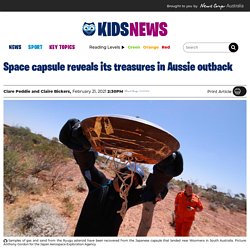
Scientists have revealed what they have found so far inside the Japanese capsule. Their trove* includes the world’s first samples of gas from deep space and sub-surface material from an asteroid — and also a mystery artificial object that has them stumped*. They are hoping that the sub-surface material, a cluster* of different-sized grains of black sand, will help answer important questions about how life evolved on Earth, such as whether key ingredients actually came from asteroids. The samples were collected from the 4.5 billion-year-old Ryugu asteroid, which is more than 15 million kilometres from Earth. Scientists were impressed by the 5.4g collection — more than 50 times the 0.1g target — retrieved from the capsule that was launched from the Japanese spacecraft Hayabusa 2.
Space experiment could help future Moon and Mars missions - CBBC Newsround. Getty Images Ever heard of mining in SPACE?!
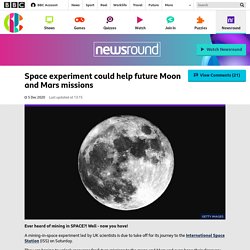
Well - now you have! A mining-in-space experiment led by UK scientists is due to take off for its journey to the International Space Station (ISS) on Saturday. They are hoping to unlock resources for future missions to the moon and Mars and even hope their discovery could help people gather the minerals needed to build a long-term presence beyond Earth.
Space ‘petrol station’ to be built in the UK – Kiwi Kids News. 1.
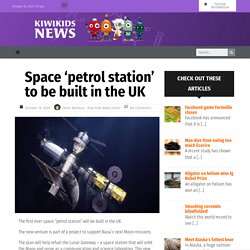
Who is the main person or group of people in this news article? 2. What was the key event from the news article? 3. Where did this event take place? 4. 1. 2. 3. 4. European Space Agency discovers 24 superhabitable planets with better conditions for life than Earth. Scientists have discovered 24 potentially* “superhabitable” planets with conditions that may be better for life than Earth.

The mysterious worlds are older, larger, warmer and possibly wetter than our planet, making them prime* targets for future alien-hunting missions. Researchers at Washington State University outlined their stunning find in a scientific paper published on October 5. The planets are 100 light-years from Earth, making them too distant to visit, but possible to study with future advanced space telescopes. Probes like the European Space Agency’s ARIEL mission, due for launch in 2028, are specially designed to seek signs of life on faraway worlds. “With the next space telescopes coming up, we will get more information, so it is important to select some targets,” the university’s Professor Dirk Schulze-Makuch said. “We have to focus on certain planets that have the most promising conditions for complex life. Why Does Earth Need Space? What do you think it would be like to see Earth from space?
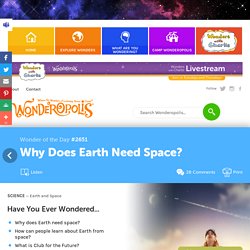
Would you feel homesick? Maybe you would find a new appreciation for the planet. Perhaps, like many, you’d be struck by a sense of awe at viewing your home from a new vantage point. Down here on Earth, it may be easy to forget the relationship between our planet and space itself. After all, we can’t often see much of the universe from where we are. Why? Space helps people learn to better care for the Earth. Speaking of other planets, space also gives Earth . . . well, more space!
NASA sends new toilet to International Space Station. Astronauts on the International Space Station are about to test NASA’s first new space toilet in decades — a $32 million titanium* toilet more suitable for women — before its eventual use on the Moon.
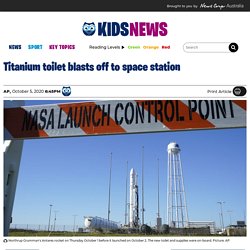
It’s packed inside a cargo ship that blasted off on Friday from Wallops Island, Virginia, US and which was scheduled to reach the ISS on Monday night Australian time. Barely 45kg and just 71cm tall, the new toilet is roughly half as big as the two Russian-built ones at the space station. It’s more camper-size to fit into the NASA Orion capsules that will carry astronauts to the Moon in a few years. Station residents will test it out for a few months and if it’s a success, it will be used regularly in the future.
With SpaceX now launching astronauts to the space station and Boeing less than a year from sending up its first crew, more toilets are needed. Jupiter’s red spot shrinks – Kiwi Kids News. 1. Who is the main person or group of people in this news article? 2.
NASA Dawn spacecraft data reveals saltwater oceans on dwarf planet Ceres. A NASA mission has discovered a saltwater ocean world in the asteroid* belt between Mars and Jupiter. Until now, freezing dwarf planet Ceres was thought to be a barren space rock. The new discovery has scientists interested in Ceres as a possible outpost* for life. Research published on Monday is based on data from NASA’s Dawn spacecraft, which flew as close as 35km from the surface of Ceres in 2018. The data provides a new understanding of Ceres, including evidence it remains geologically active with cryovolcanism — volcanoes oozing icy material.
Hubble. Dark Sky Sanctuary - Classroom - BTN. What do you see when you look up to the night sky? Maybe the moon and a few stars shimmering in the distance, if there are no clouds around. But for many of us, the sky isn't dark enough to see everything that's really up there and that's where these guys feel they're pretty lucky. They live in Australia's first ever dark sky reserve. It covers more than three thousand square kilometres around the Murray River in South Australia and includes the small town of Swan Reach. TIMOTHY: I heard that the dark night sky reserve here is actually one of the darkest night skies in the whole entire planet. CORA: It's really cool that you get to see how clear the stars are, and the moon.
The sky in this area is special because it has barely any light pollution. NASA crowdsourcing competition for design of astronaut toilets for 2024 Moon mission. NASA has launched a competition offering almost $30,000 for the best new space toilet design. NASA needs a new toilet for astronauts ahead of its planned 2024 flight to the Moon. The agency issued its invitation on HeroX, a platform where organisations can use crowdsourcing* to find solutions to complex problems.
While there are already space toilets at the International Space Station (ISS), they are designed for microgravity, meaning people and objects appear to be weightless. NASA Kepler telescope finds Earth-like planet and sun. Scientists have found a potentially habitable* exoplanet that is similar to Earth and orbits* a star similar to our Sun. The promising discovery was made in a nearby solar system and is said to be the most similar planet-star set-up to our own that’s ever been found.
The exoplanet candidate* is called KOI-456.04 and is still being considered for official planet status. An exoplanet is just a planet that is found in a different solar system to our own and KOI-465.04 was found 3000 light years away. These Stunning Yellow Swirls Could Be The First Evidence Of A New Planet Being Formed Kids News Article. Over the past two decades, powerful instruments, like the now-retired Kepler space telescope, have allowed astronomers to identify thousands of exoplanets.
While the unique new worlds, which range from fiery gas giants to icy spheres, have helped increase astronomers' knowledge about the development of planets, the process of how they form has always been a mystery.
ESA at 45: Five exciting European Space Agency projects being worked on - CBBC Newsround. Space spiral seen through Chile telescope believed to be new exoplanet forming. For the first time, astronomers have watched what they believe was the birth of a new planet. The big event happened within a huge disk of dense* gas and dust surrounding a newly formed star called AB Aurigae. Swan: Watch the skies for newly discovered comet - CBBC Newsround. Getty Images Comets, like this one, Comet West, can sometimes be seen by the naked eye. Eta Aquariids meteor shower from tail of Halley’s comet lights up night sky. Ancient debris* from Halley’s comet will zoom across the night sky this week, creating the second meteor shower in a fortnight. The eta Aquariid* meteor shower is expected to peak on Tuesday and Wednesday (but it’s worth looking all this week) and you could see up to 20 meteors an hour zoom through the early morning sky. Aussie-made food on the menu for astronauts. Australian scientists are cooking up astronaut food to send to space for a year before testing how tasty it is using an electronic nose and tongue.
The goal is to find a better way to prepare, store and serve meals for long space missions to the Moon and Mars. Adelaide University chemical engineer Professor Volker Hessel plans to send samples to the International Space Station in September. The food will stay a year on board before returning to Earth, where scientists will assess its long-term stability* and whether it’s still satisfying to eat using a hi-tech version of human taste and smell sensors. “Food is crucial* for space exploration and human colonisation* of space,” Prof Hessel said.
“It has to do with nutrition content, so you get what you need, but also has to do with the flavour, which has a big impact on morale* and behaviour. His team is experimenting with a new method for disinfecting* food, which can also be used to change food flavour, feel and smell. NASA and Space X searching for gold in space – Kiwi Kids News. Space: Extreme planet discovered where it rains iron - CBBC Newsround. ESO/M. Kornmesser. Kids News: Japan’s space elevator linking Earth to space with a cable has begun. NASA’s New Frontiers program to launch Dragonfly drone mission to Saturn’s moon Titan. NASA is sending a dragonfly into space so we can look around Saturn’s largest moon to see if humans or some form of life could live there. The US space agency has announced it has a team working hard on an incredibly advanced drone — called Dragonfly — to send to explore Titan. Using propellers, the drone will fly and land on several spots on the icy moon to study whether it can support microbial* life.
Stunning Meteor "Fireball" Deposits A 4.5-Billion-Year-Old Rock In Costa Rica Kids News Article. Exoplanets - Classroom - BTN. Light pollution: Rural England campaign says stars are hard to see - CBBC Newsround. The Mystery Of Saturn's Ravioli-Shaped Moons Has Finally Been Solved Kids News Article.
Black Hole. China artificial moon. Mars. Chang'e. ISS. After meteor lights up Perth sky, hunt begins for meteorite that crashed to Earth. King of the Planets now King of the Moons. NASA's New Horizons Rings In 2019 With The Most Distant Flyby In Space History Kids News Article. Nasa's planet-hunting Tess satellite launches into space - CBBC Newsround. Juno: What new things will we learn about planet Jupiter? - CBBC Newsround. Ever wondered what the Earth looks like from space? - CBBC Newsround. Richard Branson's Virgin Galactic rocket ship reaches the edge of space - CBBC Newsround. Meet the first women in space - CBBC Newsround. Parker Solar Probe: Nasa launches mission to 'touch the Sun' - CBBC Newsround.
ICESat-2: Five facts about Nasa's new space laser - CBBC Newsround. Space new for kids.